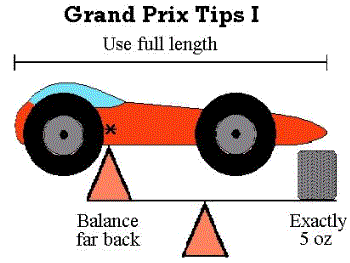
| Grand Prix Racing - | How To Make A Fast Pinewood Car |
The physics of Grand Prix racing indicates that the weight placement is dictated by your car's length, the track's initial slope and following drop, if any. Hills, waves, loops, etc. make no further difference. All tracks begin down hill. Some have drops (s-shaped). Not all flatten at the end.
Three design factors will determine how much potential energy is available to your car at the starting line. Potential energy is your car's reserve of power. The shape of your track will determine how that reserve is actually used in a race. Sometimes decreasing it can turn reduced friction to your advantage! Alter your use of these design factors depending on the over-all shape of your track:

Getting your car to balance as far to the rear as possible is not easy. The weight must be moved backward. Making your car full length and recutting your axle slots allows the weight to be moved back farther. You will want most of your car's weight to be in free weight, not tied up in the body, chassis or wheels.
By using a moveable free weight system, you can maximize your car's weight and place its balance point almost anywhere you want to. The most widely used system uses lead as the weight. Fishing weights and aquarium weights are often made of lead. Lead can be pounded to shape or melted easily and poured into holes drilled in your car's chassis.
A buffer weight of clay or loose lead chips can be used to fine tune your car's weight at the scale on race day. It is easy to add and remove. If placed in the lead well, a sticky label can be pressed over it and finished - allowing easy access on race day.
It must be noted that there is some risk to moving the weight back. If it is moved within a quarter inch of the rear axle, the front end becomes very light and may hop on a bumpy track. If your car balances behind the rear axle, your car will want to "stand" on its rear wheels, front in the air.
There are some benefits also. With the weight in the back, it becomes difficult to make a lifted front wheel touch the track. Ill effects of bobbing are eliminated. The energy normally absorbed by the lifted wheel is available for speed.
This race ends on the ramp so the weight placement makes NO difference for a well-constructed car. But if you want to reduce the side-to-side effects of possible wheel misalignment, place the weight right in the middle of the front and rear axle grooves. Car length is of little importance. However, an axle separation that is too short can lead to excessive motion back and forth across the lane.
The concerns on this kind of track are opposite those of the steady down slope! Your car must be as short as possible to move the weight forward. But be careful, the shorter wheelbase may cause some side-to-side shuffling about the lane median. Also, you'll want to know how short is short! If the flat is long enough, the long, rear-weighted car will be favored by this kind of track - what a split personality! See Grand Prix Racing - The Science of Fast Pinewood Cars.
| [Next Section] | [Title Page] |
| Grand Prix Racing - | How To Make A Fast Pinewood Car |
| Copyright © 1997, 2000, 2001, 2002, 2004 by Michael Lastufka, All rights reserved worldwide. | |